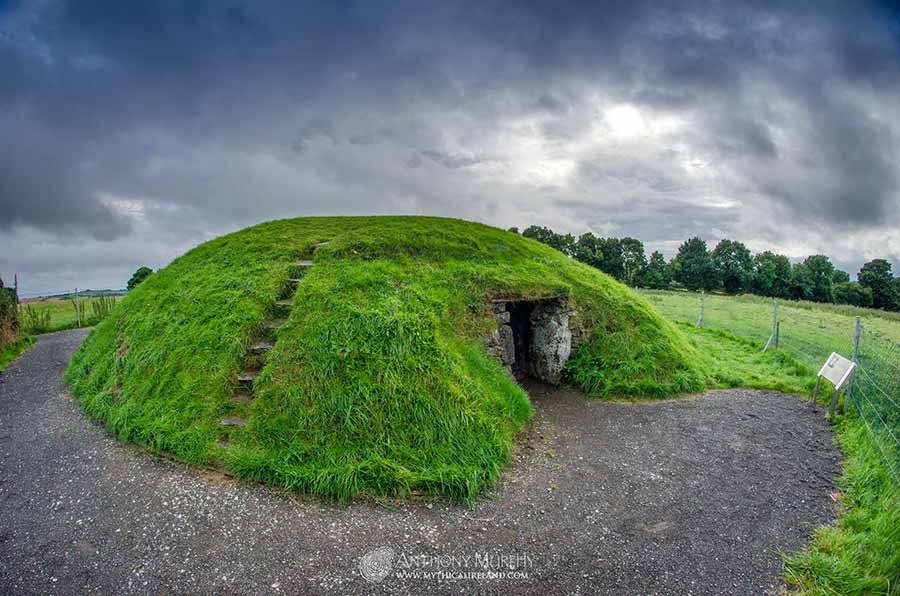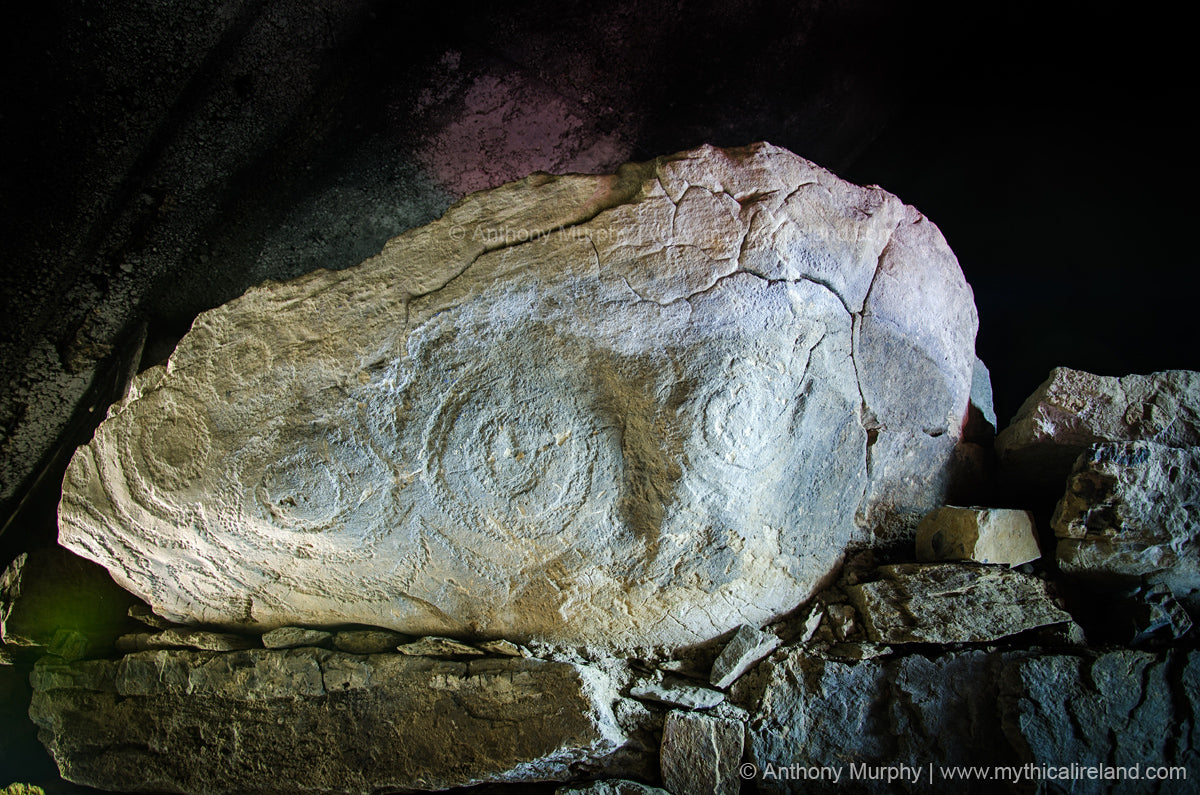
Fourknocks - Na Fuar Cnoic
Fourknocks is a small Neolithic burial mound in southeastern County Meath. The mound is part of a complex of small sites in the area, and is significant to Newgrange because it is aligned with the axis of winter solstice sunrise from Newgrange. Strangely though, the Fourknocks mound is not visible from Newgrange. It is thought that Fourknocks was built c 3000BC. It has a large chamber and a very short passage.
The name Fourknocks comes from the Irish Fuair Cnoic, which means 'The Cold Hills'. The mound (known as Fourknocks Site I) was excavated along with the nearby Site II in the 1950s by archaeologist P.J. Hartnett from County Cork. The site was reconstructed with a concrete domed roof, although no roof was found during excavation. Near the centre of the floor was found a posthole which it has been suggested may have formed a support for a wooden roof on the mound.
Get the definitive guide book to the Fourknocks monument.
A number of individuals (estimated to be around 65 people, including adults and children) were interred in Fourknocks, with deposits of cremated and inhumed remains found in both the passage entrance and in the chamber.
Zig-zags (chevrons) are a prominent feature on many engraved stones from the Neolithic. The entrance lintel stone, which was moved into the chamber of the mound during excavations to preserve it from weathering, features a series of eight diamond or lozenge-shaped markings surrounded by zig-zags.


This amazing antler pin was found at Fourknocks. It was made by splitting the shed tine of a young deer, and is D-shaped in cross section. It is 19mm long and has a slightly expanding domed head. (Knowth and the passage-tombs of Ireland, George Eogan)
"The ornament consists of a chevron pattern on the rounded part of the body, formed by cutting. Care was taken in its manufacture and the surface was well-polished, even extending into the cuts."
The Fourknocks chamber is 41.92 sq. metres in area, considerably bigger than those at Newgrange (16.50), Knowth East (20.21) and Dowth South (15.21).1 In relation to the overall size of the chamber, the recesses at Fourknocks are small, and so too is the passage, with an area of just 5.67 sq. metres compared with 14.78 for Newgrange and about 30 sq.m. for Knowth East. In fact, Fourknocks has the LARGEST chamber floor area of ANY excavated Irish passage-tomb, something I highlighted in my book about this very special monument.
According to Eogan (1986), there was a small patch of paving in the passage at Fourknocks. Sod or boulder clay was used in the construction of the mound, and small stones were "grouped together" to form a "symbolic kerb".
Most of the orthostats and roof lintels at Fourknocks are carboniferous limestone, which may possibly have been brought to the site from nearby outcrops. Apart from one example, all the decorated stones at Fourknocks are green gritty sandstones.

The large size of the chamber of Fourknocks meant it would be difficult to envisage a beehive-style stone roof on the structure. P.J. Hartnett, who excavated the site, suggested the roof was finished by using timbers supported on a central post. A post hole was found in the centre of the chamber floor, but whether this indicates the presence of a wooden roof is open to debate. Some believe the roof may have been made of a tarpaulin of cow-hide or similar material. Others believe the chamber was never roofed. Because the passage of Fourknocks is oriented to approximately 14 degrees east of north, it does not point to a sunrise or indeed a moonrise, so an astronomical function would probably have involved the stars.
The presence of zig-zag patterns on a number of stones in Fourknocks is suggestive of the W-shaped constellation, Cassiopeia, which would have been visible through the Fourknocks passage between 3000BC and 2500BC, around the time the site was constructed. Martin Brennan (The Stones of Time) has suggested that quadrangles and zigzags could be images of star fields. He says the association of quadrangular patterns and stars is common to many cultures.
The number of people buried at Fourknocks I (three mounds were excavated in the early 1950s; Fourknocks I is the monument discussed on this page; the nearby Fourknocks II was an unusual monument believed by archaeologists to be a cremation monument; Fourknocks II, some 400m to the east, was found to be a Bronze Age burial mound) is somewhere between 60 and 70, in line with estimates carried out following the excavation in 1950. A recent study by Dr. Jessica Smyth of UCD and Dr. Jonny Geber of Edinburgh University, found the minimum number of people buried at Fourknocks I was 67 - 23 unburnt individuals and 44 cremated.

I believe the passage was also oriented towards the rising of another important star, Deneb, which is the bright "tail" star of the constellation Cygnus. This may have been a precessional calculation, given that around 3,000BC, give or take a few centuries, Deneb and Cassiopeia are at their lowest elevation. This was the only epoch in the 25,920-year precessional cycle when these constellations were not circumpolar. During the rest of the cycle, they do not set below the horizon from this latitude. Perhaps the builders of Newgrange and Fourknocks knew this.
The passage of Newgrange points to Fourknocks, although neither site is intervisible. Also, Cygnus is distinctly cruciform in shape, just like the passage at Newgrange. The legend of the romance of Oengus (who owned the Brugh) and Caer tells how Caer was a swan, and after Aonghus fell in love with her at the "Lake of the Dragon's Mouth" (possibly the constellation Draco), they flew back to Newgrange and lived "in the Brugh" after that.
If we consider that Newgrange points to Fourknocks, and that Fourknocks in turn points to the rising place of the "swan star" Deneb, it could be speculated that the building of these sites might have been part of some great astronomical construct, designed to capture a specific moment in astronomical time. If this is the case, it demonstrates that the people of the Neolithic might have been aware of the great cycle of precession.
Furthermore, a large flock of wintering whooper swans comes to Newgrange every year. There are a number of ancient legends which connect swans with Newgrange, including the romance of Aonghus and Caer, and the conception of Sétanta (Cuchulainn) at Newgrange by Dechtine and Lugh, in which story Dechtine arrives at Newgrange with other maidens in the form of swans. This story takes place during winter time, which is suggestive of the solstice. The story of the fate of the children of Lir tells how the Milesians, so moved by the plight of the swans, introduced a law in Ireland that no swan was to be harmed.

Another astronomical significance of the swan constellation is the fact that Deneb is a good marker for the position of the sun on the night before winter solstice. See more about this on the Cygnus Enigma page.
Gaining access to Fourknocks
The key for the entrance door to Fourknocks passage-tomb can be obtained from Margaret White +353 (0) 1 8354722 (before 6pm). Mrs. White lives over a mile from the monument. Directions are signposted from Fourknocks, and can be found by typing 'Fourknocks Key Pick Up' into Google Maps. The house is found west of the monument – turn left at the Y-junction with the white and green house then keep going straight up the narrow track, after where the main road turns to the left. The Whites' house is some distance down that road – the 5th on the right. The house has two gateways and a sign on the wall between them reads "White". A cash deposit of €20 must be given. This is refundable on the safe return of the key. The key should be returned before 6pm. Remember not to leave any valuables in your car while visiting Fourknocks. Do not give the key to anyone else, and take any litter home with you. Take care of our ancient monuments. Thank you.
Footnotes:
1. Eogan, George (1986), Knowth and the passage-tombs of Ireland, Thames & Hudson, p. 98.

Take a tour of Fourknocks
If you'd like to take a tour of Fourknocks, perhaps as part of a bigger tour of the Boyne Valley area, Mythical Ireland Tours would be happy to try to facilitate you. Email mythicalireland@gmail.com to enquire about a Fourknocks tour.
Further reading
Suggested books: Fourknocks: archaeology, astronomy and mythology, by Anthony Murphy; Landscapes of Neolithic Ireland - Gabriel Cooney; Knowth and the passage tombs of Ireland - George Eogan. Temples of Stone - Carlton Jones.
See a short video I made at Fourknocks below:
Where is Fourknocks located? See this Google map for the location of this ancient megalithic treasure:

